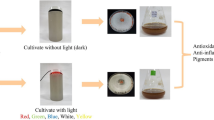Abstract
In earlier investigations, Perilla frutescens (L.) Britt. cv. Chookyoupjaso (CJC) mutants were obtained following mutagenesis induced by 200 Gy of γ-rays. The aim of this study was to compare the CJC and 6 P. frutescens (L.) Britt. cv. Chookyoupjaso mutant lines (CJMs), with respect to their phytochemical profiles and to evaluate anti-inflammatory properties by selecting the most bioactive CJM. The methanol extracts of CJMs were tested for inhibition of nitric oxide (NO) production in lipopolysaccharide (LPS)-stimulated RAW 264.7 macrophage cells. Among them, CJM-45 showed significant inhibition of NO production. This extract was further partitioned using ethyl acetate (EtOAc), butanol (BuOH), and water. The EtOAc fraction (EF-cjm45) was evaluated for antiinflammatory activities. These results indicated that the EF-cjm45 reduced NO production by inhibiting inducible nitric oxide synthase (iNOS) expression. The EF-cjm45 treatment also significantly diminished expression of MCP-1 and IL-6. In the EF-cjm45, perillaketone, isoegomaketone, ursolic acid, kaempferol, and rosmarinic acid were also found. This study reveals the potential therapeutic use of bioactive CJM-45 and justifies the wide application for this plant in traditional medicine.
Similar content being viewed by others
References
Peng Y, Ye J, Kong J. Determination of phenolic compounds in Perilla frutescens L. by capillary electrophoresis with electrochemical detection. J. Agr. Food Chem. 53: 8141–8147 (2005)
Ueda H, Yamazaki C, Yamazaki M. Luteolin as an antiinflammatory and anti-allergic constituent of Perilla frutescens. Biol. Pharm. Bull. 25: 1197–1202 (2002)
Yamamoto H, Sakakibara J, Nagatsu A, Sekiya K. Inhibitors of arachidonate lipoxygenase from defatted perilla seed. J. Agr. Food Chem. 46: 862–865 (1998)
Nakamura Y, Ohto Y, Murakami A, Ohigashi H. Superoxide scavenging activity of rosmarinic acid from Perilla frutescens Britton var. acuta f. viridis. J. Agr. Food Chem. 46: 4545–4550 (1998)
Ueda H, Yamazaki M. Anti-inflammatory and anti-allergic action by oral administration of a Perilla leaf extract in mice. Biosci. Biotech. Bioch. 65: 1673–1675 (2001)
Ishikura N. Anthocyanins and flavones in leaves and seeds of Perilla plant. Agr. Biol. Chem. Tokyo 45: 1855–1860 (1981)
Aritomi M, Kumori T, Kawasaki T. Cyanogenic glycosides in leaves of Perilla frutescens var. acuta. Phytochemistry 24: 2438–2439 (1985)
Tada M, Matsumoto R, Yamaguchi H, Chiba K. Novel antioxidants isolated from Perilla frutescens Britt. var. crispa (Thunb). Biosci. Biotech. Bioch. 60: 1093–1095 (1996)
Campbell CG, Mehra RB, Agrawal SK, Chen YZ, Abd El Moneim AM, Khawaja HIT, Yadov CR, Tay JU, Araya WA. Current status and future strategy in breeding grasspea (Lathyrus sativus). Euphytica 73: 167–175 (1993)
Brunner H. Radiation induced mutations for plant selection. Appl. Radiat. Isotopes 46: 589–594 (1995)
Lee YI, Kim JK, Lee IS, Kim DS. Variation of leaf flavor components in progenies of perilla mutants induced by gamma ray. Korea J. Breed. 31: 114–118 (1999)
Abdulla RF, Fuhr KH. An efficient conversion of ketones to α,β-unsaturated ketones. J. Org. Chem. 43: 4248–4250 (1978
Namata A, Yang P, Takahashi C, Fujiki R, Nabae M, Fujita E. Cytotoxic triterpenes from a Chinese medicine, Goreishi. Chem. Pharm. Bull. 37: 648–651 (1989)
Kim BG, Kim H, Kim JH, Lim Y, Ahn JH. Synthesis of ermanin, 5,7-dihydroxy-3,4′-dimethoxyflavone from kaempferol, 3,5,7,4′-tetrahydroxylflavone with 2 O-methyltransferases expressed in E. coli. Bull. Korean Chem. Soc. 27: 357–358 (2006)
Simpol LR, Otsuka H, Ohtani K, Kasai R, Yamasaki K. Nitrile glucosides and rosmarinic acid, the histamine inhibitor from Ehretia philippinensis. Phytochemistry 36: 91–95 (1994)
Alderton WK, Cooper CE, Knowles RG. Nitric oxide synthases: Structure, function, and inhibition. Biochem. J. 357: 593–615 (2001)
Stadler K, Bonini MG, Dallas S, Jiang J, Radi R, Mason RP, Kadiiska MB. Involvement of inducible nitric oxide synthase in hydroxyl radical-mediated lipid peroxidation in streptozotocininduced diabetes. Free Radical Bio. Med. 45: 866–874 (2008)
Wellen KE, Hotamisligil GS. Inflammation, stress, and diabetes. J. Clin. Invest. 115: 1111–1119 (2005)
Baggiolini M. Chemokines and leukocyte traffic. Nature 392: 565–568 (1998)
Morand EF, Leech M, Bernhagen J. MIF: A new cytokine link between rheumatoid arthritis and atherosclerosis. Nat. Rev. Drug Discov. 5: 399–411 (2006)
Sohn KH, Lee HY, Chung HY, Young HS, Yi SY, Kim KW. Antiangiogenic activity of triterpene acids. Cancer Lett. 94: 213–218 (1995)
Balanehru S, Nagarajan B. Protective effect of oleanolic acid and ursolic acid against lipid peroxidation. Biochem. Int. 24: 981–990 (1991)
Ovesna Z, Vachalkova A, Horvathova K, Tothova D. Pentacyclic triterpenoic acids: New chemoprotective compounds. Minirev. Neoplasma 51: 327–333 (2004)
Garcia-Mediavilla V, Crespo I, Collado PS, Esteller A, Sanchez-Campos S, Tunon MJ, Gonzalez-Gallego J. The anti-inflammatory flavones quercetin and kaempferol cause inhibition of inducible nitric oxide synthase, cyclooxygenase-2, and reactive c-protein and down-regulation of the nuclear factor kappaB pathway in chang liver cells. Eur. J. Pharmacol. 557: 221–229 (2007)
Author information
Authors and Affiliations
Corresponding author
Rights and permissions
About this article
Cite this article
Park, Y.D., Lee, Y.M., Kang, M.A. et al. Phytochemical profiles and in vitro anti-inflammatory properties of Perilla frutescens cv. Chookyoupjaso mutants induced by mutagenesis with γ-ray. Food Sci Biotechnol 19, 305–311 (2010). https://doi.org/10.1007/s10068-010-0044-8
Received:
Revised:
Accepted:
Published:
Issue Date:
DOI: https://doi.org/10.1007/s10068-010-0044-8




